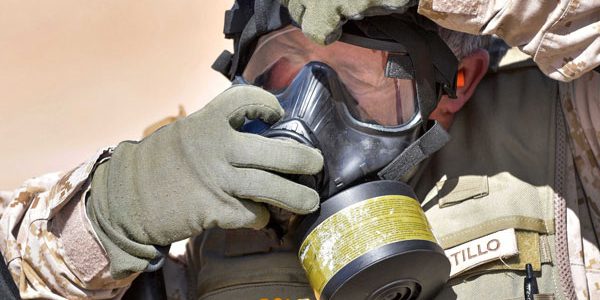an email newsletter released every month highlighting the latest articles, events, technical inquiries, and voices from the community
Respiratory Protection for Military and Law Enforcement Professionals

Posted on November 22, 2021 | Completed on November 18, 2021
What is the standard respiratory protection for military and law enforcement professionals - tight or loose fitting?
1.0 TI Response
Homeland Defense and Security Information Analysis Center staff searched open sources and reached out to various contacts at federal regulatory establishments for any information regarding the standards in respiratory protection for law enforcement and military personnel. Depending on the jurisdiction of the agency, the following regulations were found:
• 29 CFR part 1910.134 [1], “Respiratory Protection,” released by the Occupational Safety and Health Administration (OSHA).
• National Institute of Justice (NIJ) Standard-0116.00 [2], “CBRN Protective Ensemble Standard for Law Enforcement.”
• National Fire Protection Association (NFPA) 1986 [3], “Standard on Respiratory Protection Equipment for Tactical and Technical Operations.”
• Office of Law Enforcement Standards (OLES), which uses OSHA, NFPA, and NIJ standards.
• 42 CFR Part 84 [4], “Respiratory Protective Devices,” used by the National Institute for Occupational Safety and Health (NIOSH).
1.1 INTRODUCTION
There are many different jurisdictions involved in regulating all the agencies nationwide, as well as all the different manufacturers of personal protective equipment. Most cases follow the typical format of a Respiratory Protection Plan outlined in OSHA’s 29 CFR part 1910.134 [1]. There are various responsibilities blended between agencies to ensure the respiratory protection standards are tested, approved, and executed by the most qualified personnel. Additionally, some states have their own respiratory protection plans approved by OSHA that can be applied to larger volumes of agencies. In other cases, a specific agency will have its own approved protection plan. However, all the formats found here resemble OSHA’s federal regulation very closely.
1.2 OSHA
In 29 CFR part 1910.134 [1], OSHA outlines all current requirements for employers and their employees. This seemed to be the standard for almost every program that was developed, regardless if the agency fell under OSHA’s regulations or not. This regulation applies to General Industry (Part 1910) but also pertains to shipyards (Part 1915), marine terminals (Part 1917), longshoring (Part 1918), and construction (Part 1926) [1]. Further research suggests that this is the template used for almost all regulations at the state level or at an individual agency.
As outlined in section 18 of the Occupational Safety and Health (OSH) Act [5], states can submit a “state plan” to allow reasonable alterations. There are 26 state plans approved by OSHA (not including territories) that have implemented their own regulations. These states include Alaska, Arizona, California, Connecticut, Hawaii, Illinois, Indiana, Iowa, Kentucky, Maine, Maryland, Minnesota, Michigan, Nevada, New Jersey, New Mexico, New York, North Carolina, Oregon, South Carolina, Tennessee, Utah, Vermont, Virginia, Washington, and Wyoming [6].
1.3 NFPA
NFPA has a highly detailed, very specific set of regulations and standards associated with the equipment used in various types of operations with various levels of chemical toxicity. It contains hundreds of specific standards and codes for law enforcement and other first responders and documents that reference standards used in military applications. These documents include “NFPA 1404 – Standard for Fire Service Respiratory Protection Training” [7], “NFPA 1986 – Standard on Respiratory Protection Equipment for Tactical and Technical Operations” [3], and “NFPA 1989 – Standard on Breathing Air Quality for Emergency Services Respiratory Protection” [8].
1.4 NIJ
Founded in 1968, NIJ is a child agency of the U.S. Department of Justice (DOJ). The NIJ has published various official and voluntary standards and test protocols. Some agencies fall under the direct jurisdiction of the DOJ and are held accountable for the publications of the NIJ, including NIJ Standard 0116.00, “CBRN Protective Ensemble Standard for Law Enforcement” [2].
1.5 OLES
OLES was created for law enforcement, corrections, and criminal justice agencies to ensure that the equipment used by those agencies is safe, dependable, and effective. OLES was integrated into the National Institute of Standards and Technology. The most current regulations can now be found under OSHA, NFPA, and NIJ, as the scope of the OLES has changed over the years.
1.6 NIOSH
NIOSH is a child agency of the Centers for Disease Control and Prevention in charge of certifying that both respirators, as well as the filters used for respirators, can provide the appropriate level of protection needed for use. NIOSH follows standard testing procedures outlined in 42 CFR Part 84 [4] to allow a constant metric to compare against, as well as a specific standard for each application, respirator, or cartridge. There are currently about 10,700 approvals issued to 122 approval holders, sourced from 244 manufacturing sites located in 30 countries [9].
REFERENCES
[1] Office of the Federal Register. “Respiratory Protection,” 29 CFR part 1910.134. https://www.ecfr.gov/current/title-29/subtitle-B/chapter-XVII/part-1910/subpart-I/section-1910.134, accessed 22 November 2021.
[2] DOJ Office of Justice Programs National Institute of Justice. “CBRN Protective Ensemble Standard for Law Enforcement,” Standard-0116.00, November 2010.
[3] NFPA 1986. “Standard of Respiratory Protection Equipment for Tactical and Technical Operations.” https://www.nfpa.org/codes-and-standards/all-codes-and-standards/list-of-codes-and-standards/detail?code=1986, accessed 22 November 2021.
[4] Office of the Federal Register. “Respiratory Protective Devices,” 42 CFR Part 84. https://www.ecfr.gov/current/title-42/chapter-I/subchapter-G/part-84?toc=1, accessed 22 November 2021.
[5] U.S. Department of Labor. “OSH Act of 1970.” Accessed 30 August 2021.
[6] OSHA. “State Plans.” https://www.osha.gov/stateplans, accessed 22 November 2021.
[7] NFPA 1404. “Standard for Fire Service Respiratory Protection Training.” https://www.nfpa.org/codes-and-standards/all-codes-and-standards/list-of-codes-and-standards/detail?code=1404, accessed 22 November 2021.
[8] NFPA 1989. “Standard on Breathing Air Quality for Emergency Services Respiratory Protection.” https://www.nfpa.org/codes-and-standards/all-codes-and-standards/list-of-codes-and-standards/detail?code=1989, accessed 22 November 2021.
[9] D’Alessandro, M. M., S. B. Schwartz, A. Levinson, and J. K. Cichowicz. “Who Does What? The Roles of NIOSH, OSHA, and the FDA in Respiratory Protection in the Workplace.” https://blogs.cdc.gov/niosh-science-blog/2021/09/09/respirator_roles/, accessed 22 November 2021.
BIBLIOGRAPHY
NIJ. “Active NIJ Standards and Comparative Test Methods.” https://nij.ojp.gov/active-nij-standards-and-comparative-test-methods, accessed 22 November 2021.
NFPA. “List of NFPA Codes & Standards.” https://www.nfpa.org/codes-and-standards/all-codes-and-standards/list-of-codes-and-standards?mode=code&code=1986, accessed 22 November 2021.
Want to find out more about this topic?
Request a FREE Technical Inquiry!

